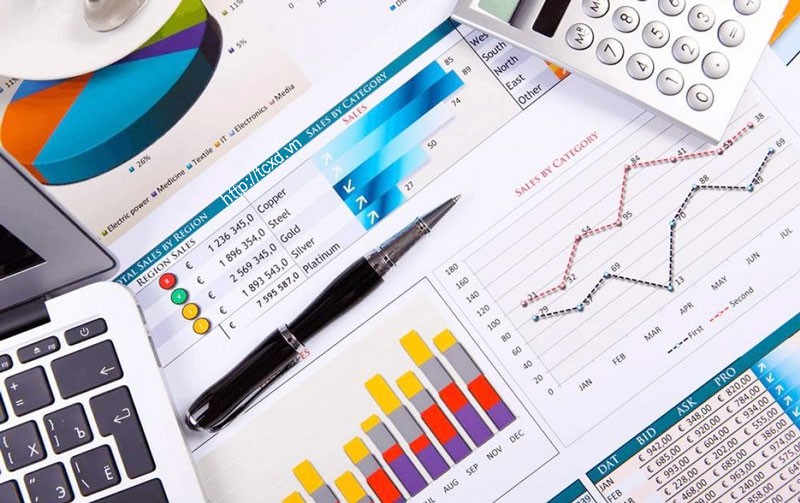PRINCIPLES OF DOCUMENT STORAGE
15:01:4727/05/2021
In saving documents, there are no standards or principles at all. But saving it correctly and making it easy to find is something that gives accountants a headache every day. CPA has collected the following tips, hoping to help accountants work more smoothly.
Principles of how to save documents that most accountants should follow:
At any time a transaction occurs, save all documents arising from that transaction in one place (ie there is 1 recording document and all original documents attached). That is, we open the file to save the document according to the name of the recording document (For example, file named Payment Voucher, File named Receipt Voucher, File named Receivable Accounting Voucher, File named Payable Accounting Voucher, File named Warehouse Receipt Voucher). , Warehouse Delivery Note File, Other accounting files... Each month is 1 file, every 12 months is 12 files).
Saving accounting documents is an extremely important step, because if you do not do this step well, later on, finding and comparing data between books and documents will be very difficult, and you will also have to find documents to restore them. Serving the tax authorities and serving the audit team. So the problem of saving documents is that each unit has a different way of saving, no unit saves the same. Below is a way to save documents for your reference and application when going to work.
At any time a transaction occurs, save all documents arising from that transaction in one place (ie there is 1 recording document and all original documents attached). That is, we open the file to save the document according to the name of the recording document (For example, file named Payment Voucher, File named Receipt Voucher, File named Receivable Accounting Voucher, File named Payable Accounting Voucher, File named Warehouse Receipt Voucher). , Warehouse Delivery Note File, Other accounting files... Each month is 1 file, every 12 months is 12 files).
Saving accounting documents is an extremely important step, because if you do not do this step well, later on, finding and comparing data between books and documents will be very difficult, and you will also have to find documents to restore them. Serving the tax authorities and serving the audit team. So the problem of saving documents is that each unit has a different way of saving, no unit saves the same. Below is a way to save documents for your reference and application when going to work.

✿✿HOW TO SAVE ACCOUNTING DOCUMENTS:
- 12 Receipt files: sandwiched with copy 3 of the output VAT invoice and goods handover record, accompanied by other related documents (Reimbursement request form, Capital contribution record)
- 12 files: Payment slip: clip with purchase invoice (remember to clip photo of invoice), Handover record, deposit slip into bank account, advance request, Payment request form, ID card and other documents other related
- Separate bank file for each bank: The bank subsidiary book of each bank is placed first, followed by the bank's Debit and Credit Notices accompanied by photocopied original documents (for example, financial purchase invoices). input) or original table to explain each banking operation
-12 files of warehouse receipt (goods or finished products): clip with the purchase invoice of the goods (remember to clip the photocopy of the invoice), accompanied by the goods handover record, economic contract (if any arises). times if any or orders, price quotes...)
- 12 Receipt files: sandwiched with copy 3 of the output VAT invoice and goods handover record, accompanied by other related documents (Reimbursement request form, Capital contribution record)
- 12 files: Payment slip: clip with purchase invoice (remember to clip photo of invoice), Handover record, deposit slip into bank account, advance request, Payment request form, ID card and other documents other related
- Separate bank file for each bank: The bank subsidiary book of each bank is placed first, followed by the bank's Debit and Credit Notices accompanied by photocopied original documents (for example, financial purchase invoices). input) or original table to explain each banking operation
-12 files of warehouse receipt (goods or finished products): clip with the purchase invoice of the goods (remember to clip the photocopy of the invoice), accompanied by the goods handover record, economic contract (if any arises). times if any or orders, price quotes...)
- 12 files of delivery note (goods or finished products): attached to the 2nd copy of the sales invoice, remember to include the goods handover record
-12 files for warehousing of raw materials: Clip the receipt for warehousing of raw materials together with the purchase financial invoice, handover record and economic contract if it arises once or for an order.
-If the company has import and export, save 12 files as the import customs declaration with REF to other relevant documents (for example, warehouse receipt or contract...) and 12 files of export customs documents. Type REF to other relevant documents (eg contract, delivery note, handover record...) to facilitate future checking and comparison.
-1 File stores the fixed asset card along with the original documents (i.e. live signed documents) that form that asset. Remember that each asset is a fixed asset card.
-Payroll file (12 payrolls): attached to the payroll is the timesheet. Salary calculation slip of each person with signature. At the same time, the bonus calculation file (accompanied by reward decisions...)
-12 files for warehousing of raw materials: Clip the receipt for warehousing of raw materials together with the purchase financial invoice, handover record and economic contract if it arises once or for an order.
-If the company has import and export, save 12 files as the import customs declaration with REF to other relevant documents (for example, warehouse receipt or contract...) and 12 files of export customs documents. Type REF to other relevant documents (eg contract, delivery note, handover record...) to facilitate future checking and comparison.
-1 File stores the fixed asset card along with the original documents (i.e. live signed documents) that form that asset. Remember that each asset is a fixed asset card.
-Payroll file (12 payrolls): attached to the payroll is the timesheet. Salary calculation slip of each person with signature. At the same time, the bonus calculation file (accompanied by reward decisions...)
- The Prepaid Expense Allocation Table file is designed to have a column of document numbers to facilitate future document lookup (Includes 12 tables for 12 months or make 1 allocation table with 12 columns from January to December )
- Fixed asset depreciation allocation table file (Includes 12 tables for 12 months or make 1 allocation table with 12 columns from January to December)
- Other accounting slips.
-1 File to save original purchase and sale invoices to coincide with monthly or quarterly VAT declarations to facilitate future tax audits and inspections
Note: the way the documents are arranged is that the DOCUMENTS THAT THE ACCOUNTANT MADE (i.e. the documents used to record books are arranged first, then the original documents are clamped) are arranged first, followed by the original documents for explanation.
- Fixed asset depreciation allocation table file (Includes 12 tables for 12 months or make 1 allocation table with 12 columns from January to December)
- Other accounting slips.
-1 File to save original purchase and sale invoices to coincide with monthly or quarterly VAT declarations to facilitate future tax audits and inspections
Note: the way the documents are arranged is that the DOCUMENTS THAT THE ACCOUNTANT MADE (i.e. the documents used to record books are arranged first, then the original documents are clamped) are arranged first, followed by the original documents for explanation.
Tin cùng chuyên mục
DỊCH VỤ KIỂM TOÁN BÁO CÁO TÀI CHÍNH LÀ GÌ? DOANH NGHIỆP NÀO BẮT BUỘC KIỂM TOÁN?
Dịch vụ kiểm toán báo cáo tài chính là gì? Doanh nghiệp nào bắt buộc kiểm toán?
Trong bối cảnh yêu...
18/12/2025
ĐIỂM MỚI TRONG XỬ PHẠT VI PHẠM THUẾ & HÓA ĐƠN: SO SÁNH NGHỊ ĐỊNH 125 VÀ NGHỊ ĐỊNH 310 (2025)
Cộng đồng kế toán và doanh nghiệp vừa đón nhận một "cú hích" pháp lý mạnh mẽ vào đầu tháng...
18/12/2025
BỎ THUẾ KHOÁN HỘ KINH DOANH: CHI PHÍ TĂNG HAY GIẢM KHI CHUYỂN SANG KÊ KHAI?
Từ ngày 1/1/2026, chính sách thuế tại Việt Nam chính thức bước sang một giai đoạn mới: bỏ thuế khoán...
18/12/2025
04 CHÍNH SÁCH ƯU ĐÃI DÀNH CHO HỘ KINH DOANH THEO NGHỊ QUYẾT 198/2025/QH15
“Cập nhật nhanh 4 ưu đãi lớn dành cho hộ kinh doanh theo Nghị quyết 198/2025/QH15: môi trường kinh doanh...
03/12/2025
DỊCH VỤ RÀ SOÁT & QUYẾT TOÁN THUẾ CHO BAN QUẢN TRỊ CHUNG CƯ – CPA HCM
Minh bạch tài chính – kiểm soát rủi ro – vận hành an toàn cho mỗi nhiệm kỳ BQT
Trong nhiều năm trở...
21/11/2025
GIẢI PHÁP KẾ TOÁN TRỌN GÓI TỪ CPA HCM GIÚP HỘ KINH DOANH AN TÂM TRƯỚC NGHỊ QUYẾT MỚI
Bạn đã nghe tin: Phương pháp thuế khoán chính thức bị xóa sổ từ ngày 01/01/2026 theo Nghị quyết...
10/11/2025
ĐIỀU KIỆN HƯỞNG ƯU ĐÃI THUẾ THU NHẬP DOANH NGHIỆP 2025: DOANH NGHIỆP CẦN LƯU Ý GÌ?
Ngày 14/6/2025, Quốc hội đã thông qua Luật Thuế Thu nhập Doanh nghiệp số 67/2025/QH15, chính thức có hiệu...
10/11/2025
TRẢI NGHIỆM ĐỊNH HƯỚNG NGHỀ NGHIỆP: Sinh Viên Văn Hiến "Thực Chiến" Cùng CPA HCM
Sinh viên Văn Hiến đã tìm thấy công thức thành công nào tại CPA HCM? Khám phá hành trình kiến tập thực...
27/10/2025
REGISTER FOR WORKERSREGISTER OF RECRUITMENT







Most Viewed News

"TOP 20 EXCELLENT ENTERPRISES IN 2024" CPA HO CHI MINH CITY AFFIRMS ITS LEADING POSITION IN THE ACCOUNTING AND AUDITING INDUSTRY
21/08/2024
In a year full of changes, CPA HCM Audit &...

CPA HCM Training Academy continues to welcome more than 500 students from Ho Chi Minh City College of Economics.
16/06/2023
What benefits will you get from this course?


FOR THE FIRST TIME SIU STUDENTS LEARN FORMAL ACCOUNTING PRACTICE IN A BUSINESS ENVIRONMENT
05/04/2024
CPA HCM AUDIT & CONSULTING COMPANY LIMITED is...

SHORT THE ROAD TO SUCCESS WITH THE COURSE "GENERAL ACCOUNTING"
08/05/2024
You have accounting knowledge but feel it is not...


“THE ROAD TRAVELLED, THE EXPERIENCE GAINED” - FAREWELL THE PROFESSIONAL ACCOUNTING COURSE 002 WITH A SMILE AND KNOWLEDGE
20/11/2023
“THE ROAD TRAVELLED, THE EXPERIENCE GAINED” -...
© All rights and copyrights belong to CPA HCM Audit and Advisory Company Limited Designed by
IMS










